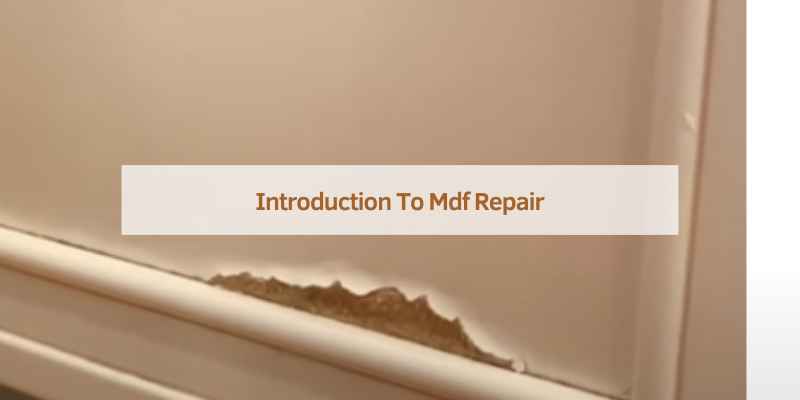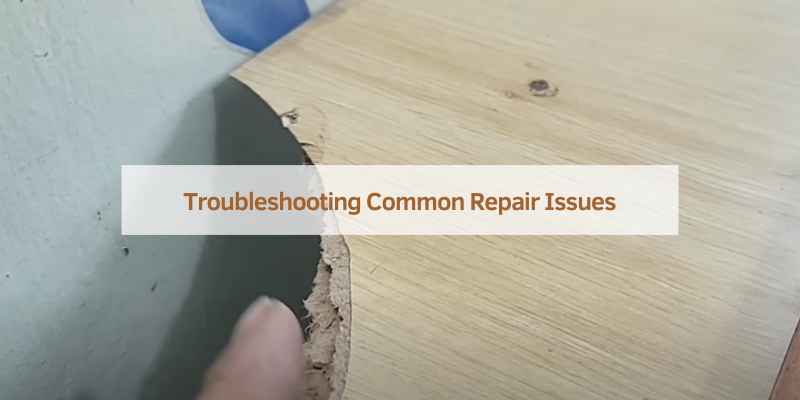To repair MDF, first clean the damaged area, then apply wood filler or epoxy, and finally sand and paint. This process restores MDF surfaces effectively.
Medium Density Fiberboard (MDF) is a popular material used in furniture and construction due to its affordability and smooth surface. Despite its durability, MDF can suffer damage such as scratches, dents, or water damage over time. Repairing MDF is a straightforward process that can extend the lifespan of your furniture or fixtures.
Begin by cleaning the damaged area to remove any dust or debris. Next, use wood filler or epoxy to fill in any cracks or holes. Once dry, sand the area smoothly and finish with a coat of paint that matches the original color. This method ensures a seamless repair and maintains the aesthetic appeal of your MDF items.
Introduction To Mdf Repair
MDF stands for Medium-Density Fiberboard. MDF furniture is popular and affordable. MDF can get damaged over time. Scratches, dents, and water damage are common problems. Fixing MDF at home can save you money. It is also a fun and rewarding project.
Scratches and dents are easy to fix. Use wood filler to fill in the gaps. Water damage can cause swelling. Sand the swollen area gently. Edges can chip off easily. Use glue to fix the edges. MDF can also crack. Apply wood glue to the cracks. Let the glue dry completely before using the furniture.
DIY repairs are cost-effective. You do not need to buy new furniture. Fixing furniture yourself is fun. It is a great learning experience. DIY repairs also reduce waste. You can keep your favorite furniture for longer. It is easy to find repair materials. Most hardware stores have what you need.

Identifying The Damage
First, look at the surface of the MDF. Check for scratches or dents. These are signs of wear. Press your finger on the surface. If it feels soft, it might be damaged. Check the edges. They can be chipped or cracked. Use a flashlight to see better. Take notes of every damage you find. This helps in fixing it later.
| Type of Damage | Description |
|---|---|
| Scratches | Small lines or marks on the surface |
| Dents | Small depressions on the surface |
| Chips | Pieces missing from the edges |
| Cracks | Lines that split the MDF |
Tools And Materials Needed
You need several tools to repair MDF. A putty knife is essential. Sandpaper will help smooth the surface. Wood filler is crucial. Clamps hold pieces in place. A screwdriver is needed for screws. A paintbrush is useful for finishing. Protective gloves will keep your hands safe. A dust mask will protect your lungs. A vacuum cleaner is handy for cleaning up dust. A damp cloth helps to wipe away debris.
Safety glasses protect your eyes. Gloves keep your hands safe. A dust mask is very important. Ear plugs protect your ears from noise. A first aid kit should always be nearby. A fire extinguisher is essential for emergencies. A good work light helps you see better. Proper footwear keeps your feet safe. Long sleeves and pants protect your skin. A sturdy workbench helps you work safely.
Preparation For Repair
Start by removing any dust and dirt from the MDF surface. Use a damp cloth to wipe it clean. Make sure the cloth is not too wet. Too much water can damage the MDF. Let the surface dry completely before moving to the next step. Clean surfaces help the repair materials stick better.
Lightly sand the area that needs repair. Use fine-grit sandpaper for best results. Sanding helps to remove rough edges and makes the surface smooth. This makes it easier to apply filler or paint. Always sand in the direction of the wood grain. Avoid over-sanding as it can damage the MDF.
Fill And Fix Techniques
MDF can get damaged easily. Wood filler is a good way to fix it. First, clean the damaged area. Then, apply the filler with a putty knife. Make sure to fill all the gaps. Let it dry for a few hours. Sand the area until it’s smooth. Finally, paint over it to match the rest of the MDF.
There are other ways to fix MDF. Epoxy resin works well for large holes. Mix the resin according to the instructions. Apply it to the damaged area. Let it dry and then sand it smooth. Bondo is another option. It’s a type of putty used in car repairs. It dries very hard and can be sanded smooth. Spackling paste can fill small holes. It’s easy to apply and dries quickly.
Finishing Touches
Painting and sealing the repaired MDF is very important. Start by sanding the surface to make it smooth. Use a primer before painting. This will help the paint stick better. Choose a high-quality paint for best results. Apply two coats of paint for even coverage. Seal the MDF with a clear sealer. This will protect it from moisture.
Matching textures is key for a seamless look. Use sandpaper to match the texture of the repaired area. Choose a paint color that matches the original MDF. Test the paint on a small area first. This ensures the color is right. Blend the new paint with the old for a uniform look. Touch up any areas that need it.
Preventative Measures
To repair MDF effectively, ensure the surface is clean and dry. Apply wood filler to damaged areas, then sand smooth once dried. For a lasting finish, seal with primer and paint.
Protecting Mdf From Future Damage
Seal the edges of MDF. This helps prevent moisture damage. Use a good quality primer or paint. Apply a protective finish to all surfaces. Avoid placing MDF in damp areas. Keep it away from direct sunlight. Use coasters and mats. This protects the surface from scratches. Regularly inspect for signs of wear.
Maintaining Mdf Furniture
Clean with a soft, dry cloth. Avoid using water or harsh chemicals. Dust regularly to prevent buildup. Use mild soap if necessary. Dry immediately after cleaning. Check for loose screws or joints. Tighten them to maintain stability. Use furniture polish for extra shine. Avoid dragging heavy objects across the surface. Lift them instead. Store in a cool, dry place.
Troubleshooting Common Repair Issues
Stubborn damage can be hard to fix. Use a sharp knife to cut out broken areas. Fill the gaps with wood filler. Let the filler dry completely. Sand the area to make it smooth. Paint or stain to match the rest of the MDF.
Seek professional help if the damage is too big. Experts have special tools. They can fix large problems quickly. Professional help is needed when you can’t fix it yourself. Large damages need special care. Professionals can make it look new again.

Frequently Asked Questions
Can Mdf Wood Be Repaired?
Yes, you can repair MDF wood. Use wood filler for small dents or scratches. For larger damages, apply epoxy resin. Sand and paint the surface for a smooth finish. Ensure proper ventilation when working with these materials.
Can You Use Wood Filler On Mdf?
Yes, you can use wood filler on MDF. It helps fill gaps, cracks, and imperfections, providing a smooth surface for painting.
How To Fix A Hole In Mdf?
Fill the hole with wood filler. Sand the area smooth once it dries. Prime and paint the surface.
Conclusion
Repairing MDF can be simple with the right tools and techniques. Follow the steps outlined for effective results. Always ensure the surface is clean and dry before starting. With patience and care, you can restore your MDF to its original condition.
Happy repairing!


